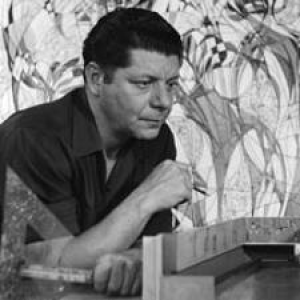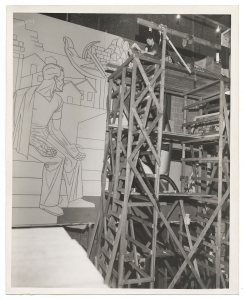

Biography
Seymour Fogel showed an early interest and aptitude for art. He studied at the Art Students League and received a scholarship to attend the National Design Academy, graduating in 1932. But he regarded his instruction at the Academy as too rote and felt he had not really learned to paint. It was his apprenticeship with Diego Rivera to work on Rivera's "Man at the Crossroads" mural for Rockefeller Center that gave Fogel his real instruction in the discipline. Rivera influenced Fogel's political outlook as well as his artistic sensibility.
Out of work in 1934, Fogel took a journey through the American South, traveling on freight trains and staying in hobo camps or anywhere he could find a place to stay and something to eat. He sketched the scenes he witnessed, including impoverished workers, bread lines and even a lynching. Back in New York he received a commission for murals at the Abraham Lincoln High School and later commissions for the 1939 World's Fair, the Social Security Building in Washington and Post Offices in Safford, Arizona and Cambridge, Minnesota. His associates during this period included Willem de Kooning, Arshile Gorky, Philip Guston, Rockwell Kent, Franz Kline and Ben Shahn.
During World War II Fogel produced anti-Fascist posters. Following the War he abandoned the figurative painting demanded of WPA artists and experimented with a variety of styles, emulating such artists as Picasso and Mondrian. In 1946 Fogel moved to Austin, Texas to join the newly-formed art department at the University of Texas. He remained in Texas until 1959, during which time he helped create the the Texas Modern Movement. While this work was in the general category of Abstract Expressionism, Fogel's approach included references to local Texas geography.
Fogel's work evolved dramatically during this period. He pioneered the use of industrial paints such as ethyl silicate for the production of murals. He began to experiment with mixing materials such as tile or sand into his artwork. The work itself became more three-dimensional where Fogel worked the surface with a palette knife. And other work was explicitly sculptural in form. Fogel created a course on art and architecture at the University of Texas. This led to collaborations with architects, and he worked to create murals that complemented the architecture of the buildings in which they were housed. In 1958, in consequence of this focus, he was named Vice President of the Architectural League of New York in 1958.
Fogel returned to the East Coast in 1959, living first in New York and later in Connecticut. He continued to experiment with different media. These experiments produced mirrored glass sculptures in the 1960s, acrylic and sand paintings in the 1970s and painted wood assemblies in the 1980s. He also continued to design murals, using mosaic tile as a favored medium.


Critical Analysis
Seymour Fogel is not an artist to be simply buttonholed. He was a social realist in the spirit of Diego Rivera. But that was only a portion of his career. He was a painter of the American Scene, but that was only when the WPA was the only employer available. He experimented in Abstract Impressionism, but he created his own kind of abstract art, seeking a direct form of visual communication, which he dubbed "atavistic."
The lines of Fogel's atavistic work bring to mind the compositions of the Russian Constructivists. And Fogel's close alliance with architects remind one of the spirit of the Bauhaus. The broad scope of his work makes it inevitable that one should compare him with whole schools of art rather than any single predecessor.
Murals
- Safford, Arizona - Post Office: History of the Gila Valley
- Washington, District of Columbia - Department of Health and Human Services: Security of the People
- Washington, District of Columbia - Department of Health and Human Services: Wealth of a Nation
- Cambridge, Minnesota - Post Office: People of the Soil
- Brooklyn, New York - Abraham Lincoln High School: African Music and European Music
- Brooklyn, New York - Abraham Lincoln High School: Religious and Modern Music
References
- Seymour Fogel (1911-1984) Modernist American double sided watercolor Young woman sleeping and Rabbi c.1940 (David Smernoff & Flavia Danica).
- Jared A. Fogel, Robert L. Stevens, The Canvas Mirror: Painting as Politics in the New Deal, Magazine of History Vol. 16, No. 1 (Fall) (2001).
- Robert L. Stevens, A Growing Storm: Depression Art of Seymour Fogel, Journal of Social Studies and History Education Volume 1 (2015).
- Seymour Fogel (1911-1984): Construction 1982 (Helicline Fine Art).
- Seymour Fogel Art (Seymour Fogel Art).
- Seymour Fogel: "Brand Em Up" (Vintage Texas Paintings).
- Seymour Fogel: On the Wall and Beyond (The Grace Museum).
- Seymour Fogel: Texas Modernist (Glasstire (Texas Visual Art)).
- Christina Rees, What It's Like to Fall in Love with Seymour Fogel, Glasstire (Texas Visual Art) September 22 (2015).